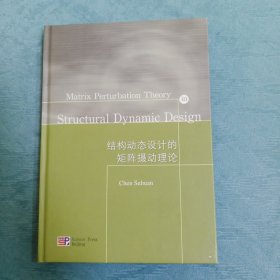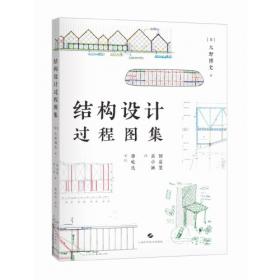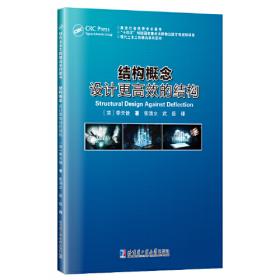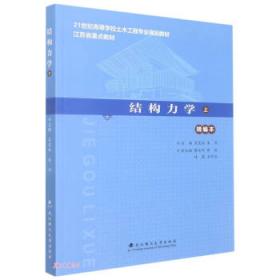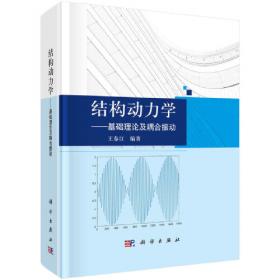结构动态设计的矩阵摄动理论
出版时间:
2007-01
版次:
1
ISBN:
9787030186980
定价:
68.00
装帧:
精装
开本:
16开
纸张:
胶版纸
页数:
248页
正文语种:
英语
-
AmatrixperturbationtheoryinstructuraldynamicdesignispresentedinthisbookThetheorycoversabroadspectrumofsubjects,theperturbaionmethodsofthedistincteigenvaluesandrepeated/closeeigenvalues,theperturbationmethodsofthecomplexmodesofsystemswithrealunsymmetricmatrices,theperturbationmethodsofthedefective/neardefectivesystems,randomeigenproblemandtheintervaleigenproblemfortheuncertainstructures.Thecontentssynthesizedthemostrecentresearchresultsinthestructuraldynamics.Numericalexamplesareprovidedtoillustratetheapplicationsofthetheoryinthisbook.
Thisbookisrecommendedtograduates,engineersandscientistofmechanical,civil,aerospace,oceanandvehicleengineering. Preface
Chapter1FiniteElementMethodforVibrationAnalysisofStructures
1.1Introduction
1.2TheHamiltonVariationalPrincipleforDiscreteSvstems
1.3FiniteElementMethodforStructuralVibrationnalvsis
1.4TheMechanicsCharacteristicMatricesofE1ements
1.4.1ConsistentMassMatrixofaRodE1ement
1.4.2ConsistentMassMatrixofaBeamE1ement
1.4.3PlateElementVibratingintheP1ane
1.4.4PlateElementinBendingVibration
1.4.5LumpedMassModal
1.5VibrationEigenproblemofStructures
1.6OrthogonalityofModalVectors
1.7TheRayleigh—RitzAnalysis
1.8TheResponsetoHarmonicExcitation
1.9ResponsetoArbitraryExcitation
1.10DirectIntegrationMethodsforVibrationEnuations
1.10.1TheCentralDifferenceMethod
1.10.2TheWilsonMethod
1.10.3TheNewmarkMethod
1.11DrectIntegrationApproximationandLoadOperatorsinModalUoordinateSystem
1.11.1TheCentralDifferenceMethod
1.11.2TheWilsonMethod
1.11.3TheNewmarkMethod
Chapter2MatrixPerturbationTheoryforDistinctEigenvalues
2.2MatrixPerturbationforDistinctEigenvalues
2.2.1The1stOrderPerturbation
2.2.2The2ndOrderPerturbation
2.2.3ComputingfortheExpansionCoefficientsclandc2
2.2.4NumericalExamples
2.3TheImprovementforMatrixPerturbation
2.3.1TheWilliamBBickfordMethod
2.3.2TheMixedMethodofMatrixPerturbationandRayleighsQuotient
2.3.3NumericalExample
2.4HighAccurateModalSuperpositionforDerivativesofModalVlectors
2.4.1TheBPWangMethod
2.4.2HighAccurateModalSuperposition
2.4.3NumericalExample
2.5MixedBasisSuperpositionforEigenvectorPerturbation
2.5.1ConstructingforMixed—Basis
2.5.2The1stOrderPerturbationUsingMixed—BasisExpansion
2.5.3The2ndOrderPerturbationUsingMixed—BasisExpansion
2.5.4NumericalExample
2.6EigenvectorDerivativesforFree—neeStructures
2.6.1TheTheoryAnalysis
2.6.2EffectofEigenvalueShiftontheConvergentSpeed
2.6.3NumericalExample
2.7ExtractingModalParametersofFree—FreeStructuresfromModesofConstrainedStructuresUsingMatrixPerturbation
2.8DeterminationofFrequenciesandModesofFree—FreeStructuresUsingExperimentalDatafortheConstrainedStructures
2.8.1GeneralizedStiffness.Mass.andtheResponsetoHarmonicExcitationforFree—FreeStructures
2.8.2Przemieniecki’sMethod(Method1)
2.8.3Chen—LiuMethod(Method2)
2.8.4Zhang—ZervaMethod(Method3)
2.8.5FurtherImprovementonZhang-ZervaMethod(Method4)
2.8.6NumericalExample
2.9ResponseAnalysistoHarmonicExcitationUsingHighAccurateModalSuperposition
2.9.1HighAccurateModalSuperposition(HAMS)
2.9.2NumericalExamples
2.9.3ExtensionofHighAccurateModalSuperposition
2.10SensitivityAnalysisofResponseUsingHighAccurateModalSuperposition
Chapter3MatrixPerturbationTheoryforMultipleEigenvalues
3.1Introduction
3.2MatrixPerturbationforMultipleEigenvalues
3.2.1BasicEquations
3.2.2Computingforthe1stOrderPerturbationofEigenvalues
3.2.3Computingforthe1stOrderPerturbationofEigenvectors
3.3ApproximateModalSuperpositionforthe1stOrderPerturbationofEigenvectorsofRepeatedEigenvalues
3.4HighAccurateModalSuperpositionforthe1stOrderPerturbationofEigenvectorsofRepeatedEigenvalues
3.5ExactMethodforComputingEigenvectorDerivativesofrepeatedEigenvalues
3.5.1TheoreticalBackground
3.5.2ANewMethodforComputingv
3.5.3NumericalExample
3.6HuSMethodforComputingthe1stOrderPerturbationofEigenvectors
3.6.1HuSSmallParameterMethod
3.6.2ImprovedHuSMethod
Chapter4MatrixPerturbationTheoryforCloseEigenvalues.
4.1Introduction
4.2BehaviorofModesofCloseEigenvalues
4.3IdentificationofModesofCloseEigenvalues
4.4MatrixPerturbationforCloseEigenvalues
4.4.1PreliminaryConsiderations
4.4.2SpectralDecompositionofMatricesKandM
4.4.3MatrixPerturbationforCloseEigenvalues
4.5NumericalExample
4.6DerivativesofModesforCloseEigenvalues
Chapter5MatrixPerturbationTheoryforComplexModes
5.1IntrOduction
5.2BasiaEquations
5.3MatrixPerturbationforDistinctEigenvalues
5.3.1BasicEquationsofMatrixPerturbationforComplexModes
5.3.2TheistOrderPerturbation
5.3.3The2ndOrderPerturbation
5.3.4ComputingforCoefficientsC1,Dl,C2andD2
5.4HighAccurateModalSuperpositionforEigenvectorDerivatives
5.4.1ImprovedModalSuperposition
5.4.2HighAccurateModalSuperposition
5.4.3NumericalExample
5.5MatrixPerturbationforRepeatedEigenvaluesofNondefectiveSystems
5.5.1BasicEquations
5.5.2The1stOrderPerturbationofEigenvalues
5.5.3The1stOrderPerturbationofEigenvectors
5.6MatrixPerturbationforCloseEigenvalues
5.6.1SpectralDecompositionofMatricesAandB
5.6.2MatrixPerturbationforCloseEigenvalues
Chapter6MatrixPerturbationTheoryforLinearVibrationDefectiveSystems
6.1Introduction
6.2GeneralizedModalTheoryofDefectiveSystems
6.3SingularValueDecomposition(SVD)andEigensolutions
6.4TheSVDMethodforModalAnalysisofDefectiveSystems
6.4.1RankAnalysisforIdentificationofDefectiveness
6.4.2SVDMethodforIdentificationofDefectivenessandModalAnalysis
6.5InvariantSubspaceRecursiveMethodforComputingtheGeneralizedModes
6.5.1InvariantSubspaceRecursiveRelationship
6.5.2SVDandReductiveMethodforComputingtheOrthogonalBasisofInvariantSubspace
6.5.3NumericalExample
6.6MatrixPerturbationforDefectiveSystems
6.6.1ThePuiseuxExpansionforEigensolutionsofDefectiveSystems
6.6.2ImprovedperturbationforDefectiveEigenvalues
6.6.3NumericalExamples
6.7MatrixPerturbationforGeneralizedEigenproblemofDefectiveSystems
6.7.1PerturbationofDefectiveEigenvalues
6.7.2ImprovedPerturbationforDefectiveEigenvalues
6.7.3NumericalExample
Chapter7MatrixPerturbationTheoryforNearDefectiveSystems
7.1Introduction
7.2RelationshipBetweenRepeatedandCloseEigenvaluesandItsIdentification
7.2.1RelationshipBetweenRepeatedandCloseEigenvalues
7.2.2IdentificationforRepeatedEigenvalues
7.2.3IdentificationforCloseEigenvalues
7.3MatrixPerturbationforNearDefectiveSystems
7.3.1MatrixPerturbationforStandardEigenproblemofNearDefectiveSystems
7.3.2MatrixPerturbationforGeneralizedEigenproblemofNearDefectiveSystems
7.4NumericalExample
Chapter8RandomEigenvalueAnalysisofStructureswithRandomParameters
8.1Introduction
8.2RandomFiniteElementMethodforRandomEigenvalueAnalysis
8.3RandomPerturbationforRandomEigenvatueAnalysis
8.4StatisticalPropertiesofRandomEigensolutions
8.5Examples
Chapter9MatrixPerturbationTheoryforIntervalEigenproblem
9.1Introduction
9.2ElementSofIntervalMathematics
9.2.1IntervalAlgorithm
9.2.2IntervalVectorandMatrix
9.2.3IntervalExtension
9.3IntervalEigenproblem
9.4TheDeifsMethodforIntervalEigenvalueAnalysis
9.5GeneralizedDeifsMethod
9.6MatrixPerturbationforIntervalEigenvalueAnalysisBasedontheDeifsMethod
9.6.1ApplicationofMatrixPerturbationtoIntervalEigenvalues
9.6.2NumericalExample
9.7MatrixPerturbationforIntervalEigenproblem
9.7.1IntervalPerturbationFormulation
9.7.2NumericalExample
References
-
内容简介:
AmatrixperturbationtheoryinstructuraldynamicdesignispresentedinthisbookThetheorycoversabroadspectrumofsubjects,theperturbaionmethodsofthedistincteigenvaluesandrepeated/closeeigenvalues,theperturbationmethodsofthecomplexmodesofsystemswithrealunsymmetricmatrices,theperturbationmethodsofthedefective/neardefectivesystems,randomeigenproblemandtheintervaleigenproblemfortheuncertainstructures.Thecontentssynthesizedthemostrecentresearchresultsinthestructuraldynamics.Numericalexamplesareprovidedtoillustratetheapplicationsofthetheoryinthisbook.
Thisbookisrecommendedtograduates,engineersandscientistofmechanical,civil,aerospace,oceanandvehicleengineering.
-
目录:
Preface
Chapter1FiniteElementMethodforVibrationAnalysisofStructures
1.1Introduction
1.2TheHamiltonVariationalPrincipleforDiscreteSvstems
1.3FiniteElementMethodforStructuralVibrationnalvsis
1.4TheMechanicsCharacteristicMatricesofE1ements
1.4.1ConsistentMassMatrixofaRodE1ement
1.4.2ConsistentMassMatrixofaBeamE1ement
1.4.3PlateElementVibratingintheP1ane
1.4.4PlateElementinBendingVibration
1.4.5LumpedMassModal
1.5VibrationEigenproblemofStructures
1.6OrthogonalityofModalVectors
1.7TheRayleigh—RitzAnalysis
1.8TheResponsetoHarmonicExcitation
1.9ResponsetoArbitraryExcitation
1.10DirectIntegrationMethodsforVibrationEnuations
1.10.1TheCentralDifferenceMethod
1.10.2TheWilsonMethod
1.10.3TheNewmarkMethod
1.11DrectIntegrationApproximationandLoadOperatorsinModalUoordinateSystem
1.11.1TheCentralDifferenceMethod
1.11.2TheWilsonMethod
1.11.3TheNewmarkMethod
Chapter2MatrixPerturbationTheoryforDistinctEigenvalues
2.2MatrixPerturbationforDistinctEigenvalues
2.2.1The1stOrderPerturbation
2.2.2The2ndOrderPerturbation
2.2.3ComputingfortheExpansionCoefficientsclandc2
2.2.4NumericalExamples
2.3TheImprovementforMatrixPerturbation
2.3.1TheWilliamBBickfordMethod
2.3.2TheMixedMethodofMatrixPerturbationandRayleighsQuotient
2.3.3NumericalExample
2.4HighAccurateModalSuperpositionforDerivativesofModalVlectors
2.4.1TheBPWangMethod
2.4.2HighAccurateModalSuperposition
2.4.3NumericalExample
2.5MixedBasisSuperpositionforEigenvectorPerturbation
2.5.1ConstructingforMixed—Basis
2.5.2The1stOrderPerturbationUsingMixed—BasisExpansion
2.5.3The2ndOrderPerturbationUsingMixed—BasisExpansion
2.5.4NumericalExample
2.6EigenvectorDerivativesforFree—neeStructures
2.6.1TheTheoryAnalysis
2.6.2EffectofEigenvalueShiftontheConvergentSpeed
2.6.3NumericalExample
2.7ExtractingModalParametersofFree—FreeStructuresfromModesofConstrainedStructuresUsingMatrixPerturbation
2.8DeterminationofFrequenciesandModesofFree—FreeStructuresUsingExperimentalDatafortheConstrainedStructures
2.8.1GeneralizedStiffness.Mass.andtheResponsetoHarmonicExcitationforFree—FreeStructures
2.8.2Przemieniecki’sMethod(Method1)
2.8.3Chen—LiuMethod(Method2)
2.8.4Zhang—ZervaMethod(Method3)
2.8.5FurtherImprovementonZhang-ZervaMethod(Method4)
2.8.6NumericalExample
2.9ResponseAnalysistoHarmonicExcitationUsingHighAccurateModalSuperposition
2.9.1HighAccurateModalSuperposition(HAMS)
2.9.2NumericalExamples
2.9.3ExtensionofHighAccurateModalSuperposition
2.10SensitivityAnalysisofResponseUsingHighAccurateModalSuperposition
Chapter3MatrixPerturbationTheoryforMultipleEigenvalues
3.1Introduction
3.2MatrixPerturbationforMultipleEigenvalues
3.2.1BasicEquations
3.2.2Computingforthe1stOrderPerturbationofEigenvalues
3.2.3Computingforthe1stOrderPerturbationofEigenvectors
3.3ApproximateModalSuperpositionforthe1stOrderPerturbationofEigenvectorsofRepeatedEigenvalues
3.4HighAccurateModalSuperpositionforthe1stOrderPerturbationofEigenvectorsofRepeatedEigenvalues
3.5ExactMethodforComputingEigenvectorDerivativesofrepeatedEigenvalues
3.5.1TheoreticalBackground
3.5.2ANewMethodforComputingv
3.5.3NumericalExample
3.6HuSMethodforComputingthe1stOrderPerturbationofEigenvectors
3.6.1HuSSmallParameterMethod
3.6.2ImprovedHuSMethod
Chapter4MatrixPerturbationTheoryforCloseEigenvalues.
4.1Introduction
4.2BehaviorofModesofCloseEigenvalues
4.3IdentificationofModesofCloseEigenvalues
4.4MatrixPerturbationforCloseEigenvalues
4.4.1PreliminaryConsiderations
4.4.2SpectralDecompositionofMatricesKandM
4.4.3MatrixPerturbationforCloseEigenvalues
4.5NumericalExample
4.6DerivativesofModesforCloseEigenvalues
Chapter5MatrixPerturbationTheoryforComplexModes
5.1IntrOduction
5.2BasiaEquations
5.3MatrixPerturbationforDistinctEigenvalues
5.3.1BasicEquationsofMatrixPerturbationforComplexModes
5.3.2TheistOrderPerturbation
5.3.3The2ndOrderPerturbation
5.3.4ComputingforCoefficientsC1,Dl,C2andD2
5.4HighAccurateModalSuperpositionforEigenvectorDerivatives
5.4.1ImprovedModalSuperposition
5.4.2HighAccurateModalSuperposition
5.4.3NumericalExample
5.5MatrixPerturbationforRepeatedEigenvaluesofNondefectiveSystems
5.5.1BasicEquations
5.5.2The1stOrderPerturbationofEigenvalues
5.5.3The1stOrderPerturbationofEigenvectors
5.6MatrixPerturbationforCloseEigenvalues
5.6.1SpectralDecompositionofMatricesAandB
5.6.2MatrixPerturbationforCloseEigenvalues
Chapter6MatrixPerturbationTheoryforLinearVibrationDefectiveSystems
6.1Introduction
6.2GeneralizedModalTheoryofDefectiveSystems
6.3SingularValueDecomposition(SVD)andEigensolutions
6.4TheSVDMethodforModalAnalysisofDefectiveSystems
6.4.1RankAnalysisforIdentificationofDefectiveness
6.4.2SVDMethodforIdentificationofDefectivenessandModalAnalysis
6.5InvariantSubspaceRecursiveMethodforComputingtheGeneralizedModes
6.5.1InvariantSubspaceRecursiveRelationship
6.5.2SVDandReductiveMethodforComputingtheOrthogonalBasisofInvariantSubspace
6.5.3NumericalExample
6.6MatrixPerturbationforDefectiveSystems
6.6.1ThePuiseuxExpansionforEigensolutionsofDefectiveSystems
6.6.2ImprovedperturbationforDefectiveEigenvalues
6.6.3NumericalExamples
6.7MatrixPerturbationforGeneralizedEigenproblemofDefectiveSystems
6.7.1PerturbationofDefectiveEigenvalues
6.7.2ImprovedPerturbationforDefectiveEigenvalues
6.7.3NumericalExample
Chapter7MatrixPerturbationTheoryforNearDefectiveSystems
7.1Introduction
7.2RelationshipBetweenRepeatedandCloseEigenvaluesandItsIdentification
7.2.1RelationshipBetweenRepeatedandCloseEigenvalues
7.2.2IdentificationforRepeatedEigenvalues
7.2.3IdentificationforCloseEigenvalues
7.3MatrixPerturbationforNearDefectiveSystems
7.3.1MatrixPerturbationforStandardEigenproblemofNearDefectiveSystems
7.3.2MatrixPerturbationforGeneralizedEigenproblemofNearDefectiveSystems
7.4NumericalExample
Chapter8RandomEigenvalueAnalysisofStructureswithRandomParameters
8.1Introduction
8.2RandomFiniteElementMethodforRandomEigenvalueAnalysis
8.3RandomPerturbationforRandomEigenvatueAnalysis
8.4StatisticalPropertiesofRandomEigensolutions
8.5Examples
Chapter9MatrixPerturbationTheoryforIntervalEigenproblem
9.1Introduction
9.2ElementSofIntervalMathematics
9.2.1IntervalAlgorithm
9.2.2IntervalVectorandMatrix
9.2.3IntervalExtension
9.3IntervalEigenproblem
9.4TheDeifsMethodforIntervalEigenvalueAnalysis
9.5GeneralizedDeifsMethod
9.6MatrixPerturbationforIntervalEigenvalueAnalysisBasedontheDeifsMethod
9.6.1ApplicationofMatrixPerturbationtoIntervalEigenvalues
9.6.2NumericalExample
9.7MatrixPerturbationforIntervalEigenproblem
9.7.1IntervalPerturbationFormulation
9.7.2NumericalExample
References
查看详情
-
九五品
福建省福州市
平均发货11小时
成功完成率98.33%
-
九品
湖北省武汉市
平均发货10小时
成功完成率94.5%
-
八五品
上海市闵行区
平均发货2小时
成功完成率97.77%

 占位居中
占位居中


